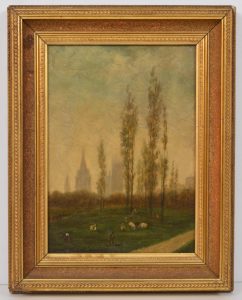 Henry Clay Angell MD (27 January 1829 – 28 May 1911) was a noted Boston ophthalmologist.
Henry Clay Angell MD (27 January 1829 – 28 May 1911) was a noted Boston ophthalmologist.
Angell graduated from the Homeopathic Medical College of Pennsylvania in 1852, briefly setting up in practice with German homeopathic physician John H. Floto (ca. 1807-1904) in Salem, Massachusetts. Like many ambitious doctors of the time, Angell travelled to Europe to complete his studies, first at the General Hospital connected with the University of Vienna, and then under doctors Franz Wurmb (1806-1864) and Carl Hugo Caspar (1817-1893) at the Leopold Stadt Homeopathic Hospital, also in Vienna.
These postgraduate studies lasted a year, after which he returned to Massachusetts and settled in Boston. However, in 1861 he returned to Europe to spend a further three and a half years studying ophthalmology, mostly under the tutelage of Professors Carl Ferdinand von Arlt (1812-1887) and Eduard Jäger (1818-1884) in Vienna, but also studying for about three months with Professor Friedrich Wilhelm Ernst Albrecht von Gräfe (1828-1870) in Berlin.
In 1864 Angell returned home and resumed practice in Boston. In 1866 he founded The New England Medical Gazette, initially serving as its sole editor, before being joined in 1867 by Dr. Israel Tisdale Talbot (1829-1899) of Boston.
In 1870 Angell published his Treatise On The Diseases Of The Eye – a work written especially for homeopaths. The first three editions were aimed at general practitioners but, after becoming Professor of Ophthalmology at the new Boston University School of Medicine in 1873, he quickly recognized the need to make his Treatise accessible to medical students. In 1876 an enlarged and much revised fourth edition was issued by Boericke and Tafel. This included a new thirty page chapter on the anatomy and physiology of the eye, along with illustrations, drawings, and three photographic plates Angell attributed to von Jaeger and the renowned physicist and physician, Hermann von Helmholtz (1821-1894), inventor in 1851 of the ophthalmoscope that revolutionized ophthalmology.
The fourth edition was translated into French by Dr. Albert de Keersmaecker, Surgeon-Oculist to the Homeopathic Dispensary at Mons, Belgium. Angell’s Treatise continued to be revised and published through a total of seven editions, the final version, in 1891, supplemented by contributions from Dr. Francis Park Lewis (1855-1940), ophthalmologist to the Buffalo Homeopathic Hospital.
In addition to his medical work Angell was also a painter of some accomplishment and an art collector, counting among his many friends the artist William Morris Hunt (1824-1879). Together with his wife, Martha Bartlett (1833-1919), Angell lived in the historical Chester Harding House at 16 Beacon Street, Boston. They also purchased a summer property in Medfield, Massachusetts in 1890 that Martha bequeathed as a nature reserve to the Animal Rescue League on her death in 1919.
Select Publications:
- The Sight, and How to Preserve It (1878)
- Records of William M. Hunt (1881)
- How to Take Care of Our Eyes: With Advice to Parents and Teachers (1891)
- Our Pictures and about Them (1909)
Angell is mentioned in Who Was Who in America (2002), Who’s Who in New England (1909), Ophthalmic Record (1911), Proceedings of the Bostonian Society, Annual Meeting (1912), The New International Year Book (1912), Biographical Index of the Graduates of the Homoeopathic Medical College (1918), Annual Report of the Museum of Fine Arts Boston (1908-1911), Catalogue of European and American Paintings and Sculpture, the New England Medical Gazette and the Pacific Coast Journal of Homeopathy.
Angell’s art collection, The Henry C. and Martha B. Angell Collection, is held at the Museum of Fine Arts in Boston.


Leave A Comment